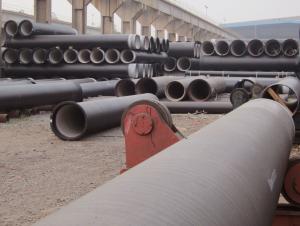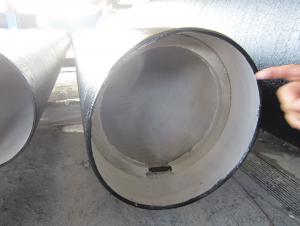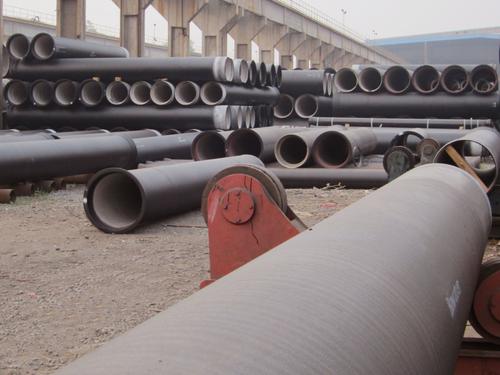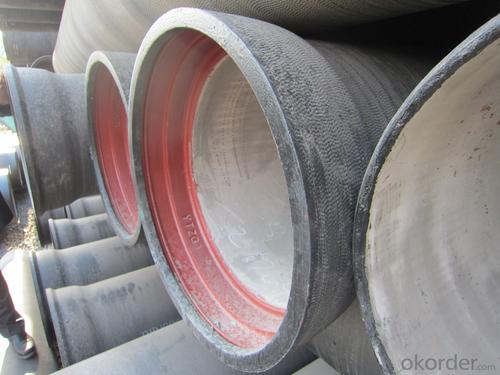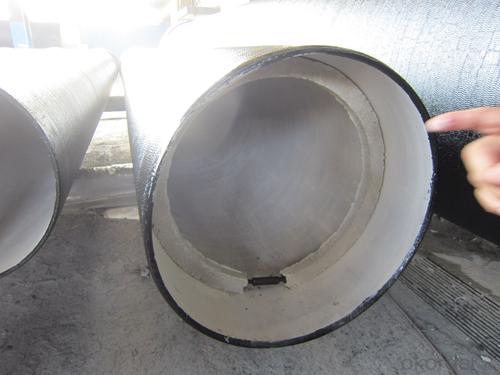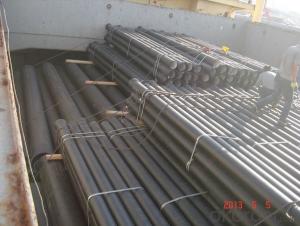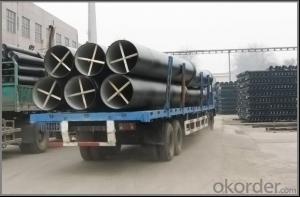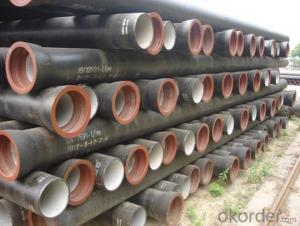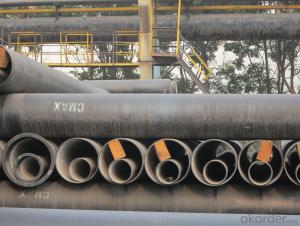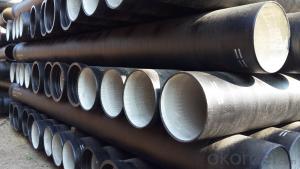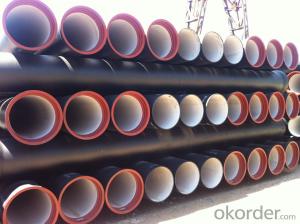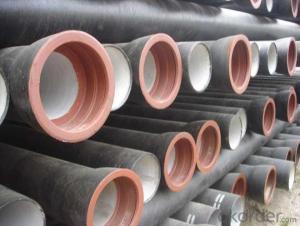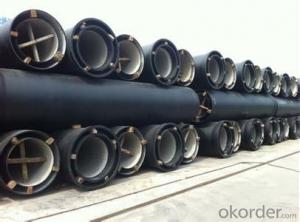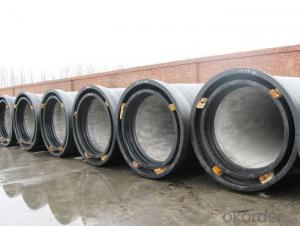Ductile Iron Pipe of China DN300 EN545/EN598/ISO2531 High Quality DI Pipe
- Loading Port:
- China main port
- Payment Terms:
- TT or LC
- Min Order Qty:
- 25 m.t.
- Supply Capability:
- 200000 m.t./month
OKorder Service Pledge
OKorder Financial Service
You Might Also Like
1. Ductile Iron Pipe Description :
2) Pipe ends: Spigot and socket ends, with 100% SBR rubber gaskets accoding to ISO4633
3) we can do third party inspection according to customer's request.
4) Our products have been sold to many international market, such as Middle East and South East Asia and Africa.
2. Main Features of the Ductile Iron Pipe:
• Chemical checking
• NDE after rough machining
• Mechanical testing after heat treatment
• Final NDE,dimension inspected
2).Quality document
• Full Q.A document as per client request
3).Packing and Shipping
• standard export package(carton/wooden case/pallet)
• accept FOB,FAS,CNF,CIF door to door etc or customer designated shipping agent
4).Service
• Drawing: we can translate your original drawing, offer best suggestion on design
• Quality: we have full set quality control system to guarantee the best quality.
• Inspection: inspect in house, all our products must be checked 3 times before packing.
3. Ductile Iron Pipe Images:

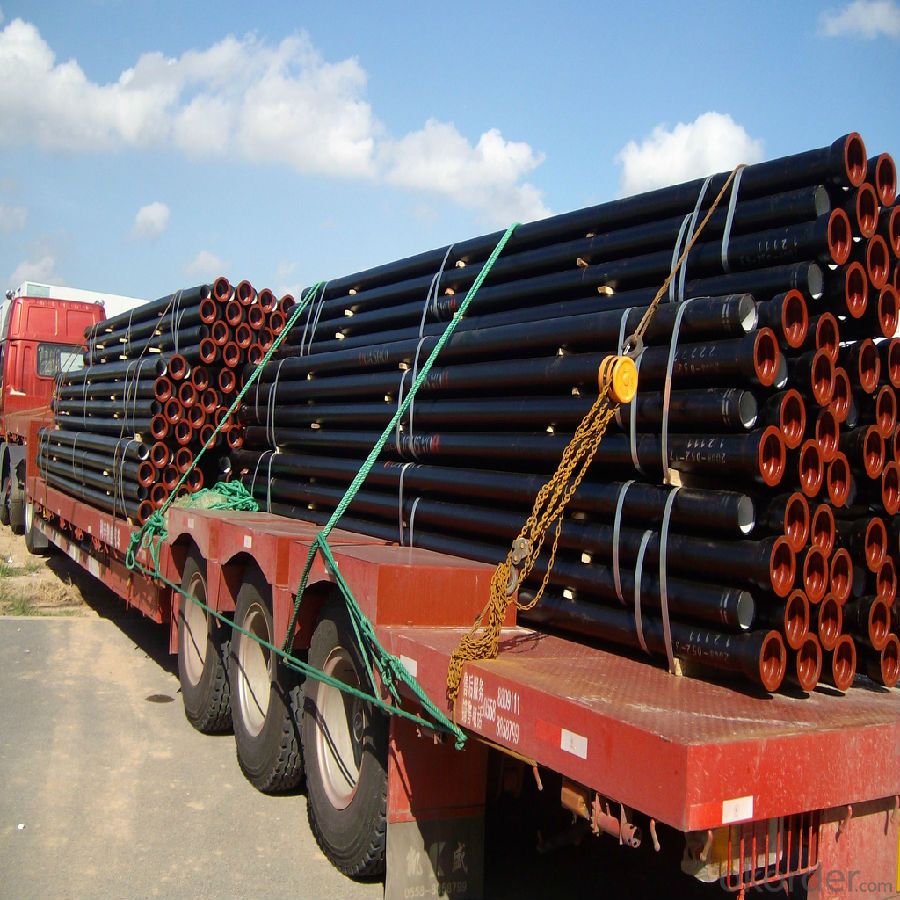
4. Ductile Iron Pipe Specification
Grade: A53 Grades A/B, ASTM A106 Grades B/C,ASTM A179,AWWA, C200, ASTM A139, ASTM A120, API 5L Grade B,X42, X52, X56, X60, X65, X70, X80, X100
Weld Alternatives: LSAW
OD size range: 6.4~44.5mm
Wall thickness: 406.4~1422mm
Length: 3 - 12 m according to requirment
Note: Other grade can also be provided after consulting. Special design are available for coal slurry conveyance LSAW line tube
5. FAQ:
1.Q: Why would you choose ductile iron pipe rather than other pipe materials?
A:The reasons are obvious for that not only ductile iron pipe possesses the inherent strength and flexibility of ductile iron, combined with proven corrosion protection systems, but also the cost savings can be achieved from design to installation and commissioning.
2.Q:Why can you guarantee the inner of pipes can’t be corroded?
A: High alumina cement mortar lining and sulphate-resistant cement mortar lining. These two special linings are applicable to inner anti-corrosion for sewage pipes, improving resistance to erosion of the sewage components.
- Q: What is the internal lining used in ductile iron pipes?
- Ductile iron pipes commonly employ a cement mortar lining as their internal coating. This lining is carefully applied to safeguard the pipe from corrosion and abrasion. By doing so, it effectively prolongs the pipes' lifespan and enables them to endure the demanding conditions of water or sewage transportation. Moreover, this lining enhances the hydraulic efficiency of the pipes by diminishing friction and averting the development of biofilms or deposits on the inner surface. In essence, incorporating a cement mortar lining into ductile iron pipes is crucial for preserving the integrity and functionality of the infrastructure.
- Q: Are ductile iron pipes suitable for use in cold climates?
- Yes, ductile iron pipes are suitable for use in cold climates. Ductile iron possesses excellent resistance to low temperatures, making it highly suitable for use in freezing conditions. Its high durability and strength enable it to withstand extreme temperatures and harsh weather conditions commonly found in cold climates.
- Q: What is the cost of ductile iron pipes compared to other pipe materials?
- The price of ductile iron pipes can vary depending on a variety of factors, including size, length, and supplier. However, when compared to materials like PVC or steel, ductile iron pipes generally tend to be more expensive. This is primarily due to the manufacturing process and the inherent qualities of ductile iron that make it a durable and dependable choice for various applications. Ductile iron pipes are renowned for their high tensile strength, resistance to corrosion, and durability. These qualities make them suitable for transporting potable water, wastewater, and other fluids under high pressure. The production process for ductile iron involves the addition of magnesium to cast iron, resulting in improved strength and flexibility. This additional step, combined with the quality of the material, contributes to the higher cost. On the other hand, pipes made from materials such as PVC or steel can be less costly. PVC pipes are lightweight, easy to install, and relatively inexpensive, making them a popular choice for low-pressure applications like irrigation or drainage systems. Steel pipes, known for their strength and durability, are often used in high-pressure situations but come with a higher price tag than PVC. In the end, while ductile iron pipes may have a higher initial cost, their longer lifespan and reliability can make up for the investment over time. Other factors, such as project requirements, local regulations, and material availability, can also impact the overall cost comparison between ductile iron pipes and other pipe materials.
- Q: Are ductile iron pipes resistant to seismic events?
- Generally, ductile iron pipes exhibit resistance to seismic events. Ductile iron, a form of cast iron known for its strength and durability, can withstand external forces, including those induced by seismic events like earthquakes. The design of ductile iron pipes allows for flexibility, enabling them to absorb and dissipate energy from seismic waves. This flexibility ensures the pipes remain intact despite ground movements and vibrations, preventing any breakage or cracking. Moreover, the joints of these pipes are designed to offer some level of flexibility, further enhancing their ability to withstand seismic events. Furthermore, the construction of ductile iron pipes involves thick walls, providing them with exceptional structural integrity. This strength reduces their susceptibility to damage during seismic events and ensures a consistent flow of fluids, such as water, even in extreme conditions. Nonetheless, it is crucial to recognize that the resistance of ductile iron pipes to seismic events can depend on various factors. These factors include the magnitude and proximity of the earthquake, the quality of installation and maintenance, and the specific design considerations for the pipeline system. Consequently, it is vital to adhere to proper engineering and construction practices to optimize the resilience of ductile iron pipes in areas prone to seismic activity.
- Q: How does ductile iron pipe perform in areas with high ground movement?
- Ductile iron pipe performs exceptionally well in areas with high ground movement. Its unique properties and design make it highly resistant to deformation and damage caused by ground shifting, settling, or seismic activities. The ductility of the material allows it to withstand significant stress and strain without fracturing or breaking. Unlike rigid materials such as cast iron or PVC, ductile iron pipe has the ability to flex and absorb ground movement, which prevents catastrophic failures and ensures the integrity of the pipeline system. Additionally, ductile iron pipe is manufactured with a variety of joint configurations that further enhance its performance in areas with high ground movement. Flexible joints, such as restrained joints or mechanical joints, accommodate the movement by allowing limited rotation and translation, minimizing the potential for pipe separation or joint failure. Furthermore, the robust construction of ductile iron pipe, which includes a thick wall thickness and a high tensile strength, provides additional protection against ground movement. This strength helps the pipe withstand external loads and forces induced by the ground, preventing deformation and maintaining its structural integrity. In conclusion, ductile iron pipe is an ideal choice for areas with high ground movement due to its exceptional ductility, joint flexibility, and robust construction. Its ability to absorb ground movement without compromising the pipeline system's functionality or safety makes it a reliable and durable option in such challenging environments.
- Q: How are ductile iron pipes made?
- Ductile iron pipes are made using a specific manufacturing process known as centrifugal casting. This process involves pouring molten iron into a rotating mold, which is usually made of steel. The centrifugal force created by the rotation of the mold helps in distributing the molten iron evenly, ensuring the final product is of high quality. To begin the manufacturing process, a mixture of scrap iron, steel, and recycled material is melted in a furnace at extremely high temperatures. Once the molten iron reaches the desired temperature and consistency, it is ready to be cast into pipes. The rotating mold is first preheated to prevent the molten iron from cooling too quickly. The preheating process also helps in ensuring a smooth surface finish of the pipes. Next, the molten iron is poured into the rotating mold through a central sprue. As the mold spins, the molten iron is forced against the inner walls of the mold due to centrifugal force. This causes the iron to solidify rapidly, resulting in a dense, strong, and corrosion-resistant pipe. The centrifugal force also helps to remove any impurities or slag from the inner surface of the pipe, further enhancing its quality. Once the casting process is complete, the mold is allowed to cool, and the pipe is removed. The pipes are then subjected to various tests to ensure they meet the required quality standards. These tests may include checking the dimensions, mechanical properties, and surface finish of the pipes. After passing the quality tests, the ductile iron pipes are typically coated with a protective lining to prevent corrosion and extend their lifespan. This lining can be made of cement mortar, epoxy, or polyethylene, depending on the intended application of the pipes. In summary, ductile iron pipes are made through the centrifugal casting process, which involves pouring molten iron into a rotating mold. This process ensures the production of strong, corrosion-resistant pipes with a smooth surface finish.
- Q: Are ductile iron pipes suitable for installation in areas with high soil settlement and consolidation?
- Ductile iron pipes are commonly used in areas where there is significant soil settlement and consolidation. One of the main advantages of these pipes is their ability to withstand external loads and accommodate ground movement. Compared to other pipe materials, ductile iron pipes are known for their strength and flexibility, making them more resistant to soil settlement and consolidation. They have a higher tensile strength and can withstand heavy loads and ground vibrations without cracking or breaking. This makes them suitable for areas with soil prone to settlement and consolidation. Moreover, ductile iron pipes have a high resistance to corrosion and can withstand aggressive soil conditions, which are often found in areas prone to settlement and consolidation. They are also less likely to be damaged by external factors such as roots or rocks, making them even more suitable for installation in such areas. However, it is important to consider the specific conditions of the site and consult with engineers or experts who are familiar with the local soil conditions. Factors such as the magnitude and rate of settlement, soil type, groundwater levels, and construction methods should be taken into account when determining whether ductile iron pipes are appropriate for installation in areas with high soil settlement and consolidation. In conclusion, ductile iron pipes are generally a suitable choice for installation in areas with high soil settlement and consolidation. Their strength, flexibility, resistance to corrosion, and ability to withstand external loads make them a reliable option for these conditions. Nevertheless, it is always recommended to assess the specific site conditions and consult with professionals to ensure the most appropriate pipe material is selected for each project.
- Q: Are ductile iron pipes compatible with other pipe materials?
- Generally, other pipe materials can be compatible with ductile iron pipes. The high level of flexibility and strength of ductile iron pipes allows for their connection with various materials like PVC, HDPE, and steel. Transition fittings are often utilized to securely and prevent leaks when connecting ductile iron pipes with other materials. To maintain the integrity of the pipeline system and ensure compatibility, it is crucial to follow industry standards and guidelines when joining different pipe materials.
- Q: What are the different types of linings available for ductile iron pipe?
- There are several types of linings available for ductile iron pipe, including cement mortar lining, polyethylene lining, and polyurethane lining.
- Q: What is the expected joint performance of ductile iron pipes?
- Ductile iron pipes are widely recognized for their outstanding joint performance. They possess exceptional durability and strength, making them suitable for a wide range of applications, including water distribution, sewer systems, and industrial pipelines. One crucial aspect of joint performance in ductile iron pipes is their ability to withstand external loads and pressure. To ensure minimal leakage and long-term structural integrity, the joints in these pipes are designed to create a tight and secure connection. This is accomplished through the utilization of various joint types, such as push-on joints, mechanical joints, and restrained joints. Push-on joints are commonly employed in ductile iron pipes due to their ease of installation. They do not require any specialized tools or equipment. These joints rely on a rubber gasket, which guarantees a watertight seal and prevents leakage. On the other hand, mechanical joints involve the use of mechanical devices, such as bolts and nuts, to establish a rigid connection between the pipes. This type of joint provides additional strength and resistance against external forces. Ductile iron pipes have undergone extensive testing to ensure their performance meets or exceeds industry standards for pressure and bending strength. They exhibit high resistance to corrosion, resulting in a longer service life. Additionally, they are less susceptible to damage caused by ground movements or vibrations. These properties contribute to the overall joint performance of ductile iron pipes, ensuring reliable and efficient operation in various infrastructure systems. When properly installed and maintained, ductile iron pipes display remarkable joint performance. They provide a reliable and durable solution for numerous applications within the water and wastewater industry.
Send your message to us
Ductile Iron Pipe of China DN300 EN545/EN598/ISO2531 High Quality DI Pipe
- Loading Port:
- China main port
- Payment Terms:
- TT or LC
- Min Order Qty:
- 25 m.t.
- Supply Capability:
- 200000 m.t./month
OKorder Service Pledge
OKorder Financial Service
Similar products
Hot products
Hot Searches
Related keywords
